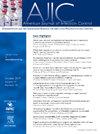Infection Prevention and Control Response and Escalation Framework: Evaluation and application beyond a pandemic
IF 3.8
3区 医学
Q2 INFECTIOUS DISEASES
引用次数: 0
Abstract
Background
The COVID-19 pandemic resulted in constant changes to Infection Prevention and Control (IPAC) recommendations, impacting clinician capacity to stay up to date. The COVID-19 IPAC Response and Escalation Framework (IPAC Framework), rarely reported or evaluated was developed to provide scalable IPAC guidance during the pandemic to health care in New South Wales (NSW), Australia.
Methods
Using a thematic analysis approach, a qualitative study using an online, cross-sectional survey comprising 27 questions was sent to 248 key stakeholders. Participants were health workers with broad clinical and system representation with responsibilities for risk assessment, communicating, implementing, or monitoring the IPAC Framework.
Results
The IPAC Framework provided a useful IPAC tool for the management of COVID-19 as perceived by 93% of respondents. The overwhelming majority (91%) reported the Framework provided enough information on IPAC strategies needed for COVID-19 that were aligned with transmission risk. Resources supporting the IPAC Framework were reported by most respondents (84%) as being widely accepted as the authoritative guidance.
Conclusions
An IPAC Framework is perceived as invaluable by clinicians and administrators to manage IPAC requirements in health care during a pandemic. The IPAC Framework can be applied more generally to support ongoing IPAC requirements.
感染预防与控制响应和升级框架--大流行后的评估和应用。
背景:COVID-19 大流行使感染预防与控制 (IPAC) 建议发生了快速而频繁的变化,临床医生很难及时了解最新的要求和指南。COVID-19 IPAC 响应和升级框架(IPAC 框架)的制定是为了在大流行期间为澳大利亚新南威尔士州的医疗保健机构提供可扩展的 IPAC 指导。此类框架在大流行期间或非大流行期间的使用情况很少有报道和评估:采用专题分析方法,向 248 名主要利益相关者发送了一份包含 27 个问题的在线横截面调查问卷,进行了一项定性研究。参与调查的人员都是卫生工作者,他们在临床和系统中具有广泛的代表性,负责风险评估、沟通、实施和/或监控 IPAC 框架:93%的受访者认为 IPAC 框架为 COVID-19 的管理提供了有用的 IPAC 工具。绝大多数受访者(91%)表示,该框架提供了有关 COVID-19 所需的 IPAC 战略的足够信息,这些战略与传播风险相一致。大多数受访者(84%)表示,支持 IPAC 框架的资源被广泛接受为权威指南:结论:临床医生和管理人员认为 IPAC 响应和升级框架在大流行期间管理医疗保健中的 IPAC 要求方面非常有用。IPAC 框架可以更广泛地应用于支持持续的 IPAC 要求。
本文章由计算机程序翻译,如有差异,请以英文原文为准。
求助全文
约1分钟内获得全文
求助全文
来源期刊
CiteScore
7.40
自引率
4.10%
发文量
479
审稿时长
24 days
期刊介绍:
AJIC covers key topics and issues in infection control and epidemiology. Infection control professionals, including physicians, nurses, and epidemiologists, rely on AJIC for peer-reviewed articles covering clinical topics as well as original research. As the official publication of the Association for Professionals in Infection Control and Epidemiology (APIC)

 求助内容:
求助内容: 应助结果提醒方式:
应助结果提醒方式:


